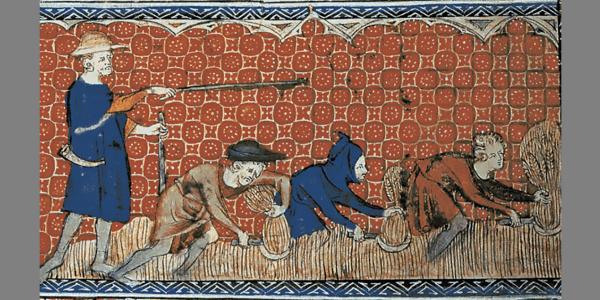Christine R. Johnson is associate professor of history in the Department of History.
“[The] mortality destroyed more than a third of the men, women, and children … such a shortage of workers ensued that the humble turned up their noses at employment, and could scarcely be persuaded to serve the eminent unless for triple wages. … As a result, churchmen, knights and other worthies have been forced to thresh their corn, plough the land and perform every other unskilled task if they are to make their own bread.”
— Account of the Black Death in the cathedral priory chronicle at Rochester (written no later than 1350)
In its entry on the Black Death, the 1347–50 outbreak of bubonic plague that killed at least a third of Europe’s population, this chronicle from the English city of Rochester includes among its harrowing details a seemingly trivial lament: Aristocrats and high clergymen not only had to pay triple wages to those toiling in their fields, but, even worse, they themselves had to perform manual labor. Curiously, the documentary record, which provides ample evidence that workers did demand and receive higher wages (on which more below), contains in contrast scant evidence that “worthies” ever dirtied their hands with fieldwork. Even if (or especially as) phantasms, however, these sickle-wielding lords reveal the importance of imagined possibilities in shaping pandemic responses.
The eminent refused to take on menial roles, not because they could not perform these “unskilled” tasks, but because to do so would be unworthy of their social rank, and it was unthinkable to abandon that social and labor hierarchy. Farm work was peasant work, whether performed by serfs bound to a particular manor, tenant farmers or wage laborers hired by the year or the season. But the staggering mortality of the Black Death reduced this previously sufficient peasant population sharply enough to create a severe labor shortage.
What happened next has been the subject of an enormous amount of scholarship, particularly in the case of England, where the large extant body of sources such as chronicles, legislation, court cases and manorial account books provides rich material for studying the social and economic changes in the wake of the Black Death. Scholars disagree about how and how much things changed, but they share a tendency to describe these changes in oddly passive terms: wages rose, inequality decreased, feudalism ended.
Yet there was a great deal of deliberate (in)action behind these developments. Rather than supply some of the needed labor themselves, landowners turned to solutions that might produce the kind of world they were capable of imagining. In England they created first the Ordinance (1349) and then the Statute (1351) of Labourers, which froze wages at pre-plague levels, compelled workers not otherwise engaged in fixed, long-term employment into year-long contracts with the first employer who demanded it, and established penalties to ensure compliance. As Jane Whittle has noted, in putting their efforts behind the control of waged labor rather than the retrenchment of (already declining) serfdom, rural landowners sought a “thinkable” resolution to this impasse: They would use the existing market for labor, but control the terms of exchange.
Many peasants, however, refused to play their assigned role of deferential wage earner. Court records from 1352, for example, show that “Edward le Taillour of Wootton, employee of the prior and convent of Bradenstoke … left his employment before the feast of St Nicholas [6 December] without permission or reasonable cause, contrary to statute,” and that John Death of Wroughton demanded an “excess” of six shillings eightpence for reaping John Lovel’s corn. Recalcitrant laborers remained a problem in 1374, when “John Fisshere, William Theker, William Furnes, John Dyker, Gilbert Chyld, Alan Tasker, Stephen Lang, John Hardlad, Cecilia Ka, Joan daughter of Henry Couper, Matillis de Ely, Alice wife of Simon Souter, all of Bardney, labourers, refused to work [for the Abbot of Bardney at the stipulated wages], and on the same day they left the town to get higher wages elsewhere, in contempt of the king and contrary to statute.”
With many state governments reducing unemployment benefits to push workers to fill open jobs, the aim, like England after the Black Death, is to reinstate and reinforce previous social and labor hierarchies, regardless of whose work has actually been “essential” over the past 16 months.
These records attest to some individuals’ appreciation of the increased value of their labor in the new marketplace created by mass death. The number and geographical range of these individual acts of defiance, moreover, suggest a vibrant, if unrecorded, current of communal discussions, rumors and calculations that supported such individual agency. In the face of official intransigence, workers pushed for higher wages and greater mobility, which they received because “churchmen, knights, and other worthies” were willing to make these concessions, rather than have to work the fields and herd the sheep themselves. As a result, wages rose, inequality lessened … and the social and labor hierarchies remained the same.
Thankfully, the current COVID-19 pandemic is vastly less lethal than the mid 14th-century bubonic plague, and we can hope that people around the world do not experience the loss of human life on the same scale. What the Black Death does share with our present moment is the issue of labor and the limits drawn by the negative space of the unthinkable.
The people who prospered under the pre-pandemic system are now deciding what “back to normal” looks like and how we get there. With many state governments reducing unemployment benefits to push workers to fill open jobs, the aim, like England after the Black Death, is to reinstate and reinforce previous social and labor hierarchies, regardless of whose work has actually been “essential” over the past 16 months. Workers in specific circumstances and with individual or collective determination might negotiate better labor conditions or higher wages, but these concessions’ permanance remains in the hands of employers who saw no reason to implement them prior to the pandemic. As historians Ada Palmer and Eleanor Janega have argued, whatever gains peasants and artisans obtained in the decades after the Black Death did not survive the following centuries. Elites successfully reclaimed a greater share of wealth and income, hierarchies ossified, and laborers’ power diminished.
Simply stating that English society was changed by the Black Death not only discounts the people who did the changing, but also ignores the insufficiencies of the changes they produced. The Rochester chronicler raised the specter of knights and churchmen toiling in the fields to evoke the unthinkable scale of the disaster, and then refused to contemplate this radically different social order any further. We are not the Rochester chronicler. How can we think the unthinkable — about safety and health, racial justice, gender roles, immigration status, access to childcare, and the dignity, autonomy and worth of labor — for our own post-pandemic future?
All quoted material from Rosemary Horrox, ed., The Black Death (Manchester University Press, 1994).
Headline image: Medieval illustration of men harvesting wheat with reaping-hooks, on a calendar page for August, circa 1310. Queen Mary's Psalter (Ms. Royal 2. B. VII), fol. 78v, The British Library.





